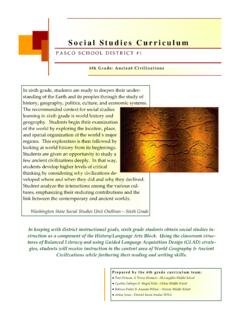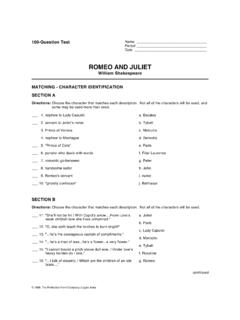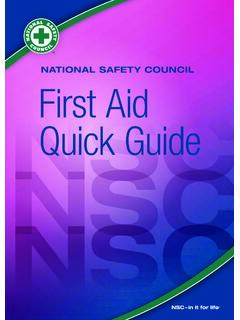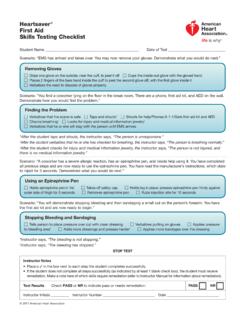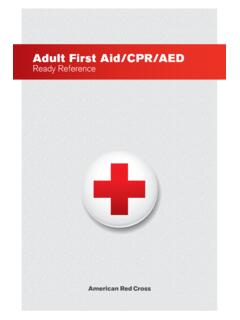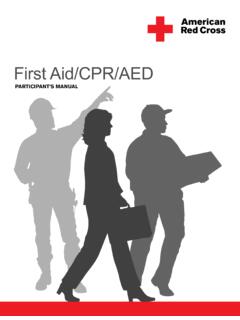Transcription of CPR, AED, AND FIRST AID FOR ADULTS WORKSHEET ANSWERS
1 CPR, AED, AND FIRST AID FOR ADULTS WORKSHEET ANSWERS . The FIRST Aid Provider 1. OSHA defines FIRST Aid as, "Emergency care provided for injury or sudden illness before professional emergency medical treatment becomes available. 2. What are the essential responsibilities of a FIRST aid provider: a. Recognizing a medical emergency b. Making a decision to help c. Identify hazards and ensuring personal safety. If unsafe, DO NOT enter. d. Activating EMS system. e. Providing supportive basic FIRST aid care. Legal Considerations 3. Who do the Good Samaritan laws protect and what do the laws say? Good Samaritan laws protect anyone who voluntarily provides assistance without expecting or accepting compensation; is responsible and prudent; does not provide care beyond their training; and, is not "grossly negligent" or completely careless.
2 4. What must you ask a person who is responsive? Ask the person if they want help. 5. What is implied consent? If a person is or becomes unresponsive, it allows a provider to help without asking because it is assumed that the person would have given consent if able to. Recognizing an Emergency and Deciding to Help 6. Mechanism of injury is the manner in which a force creates an injury. Personal Safety 7. What is most commonly used barrier? What are 2 keys points to removing them when done. Disposable gloves are the most commonly used barrier. When done using them, remove them carefully and wash your hands when done.
3 Dispose of gloves properly. Emergency Medical Services 8. Immediate EMS activation is recommended when a person is unresponsive, a significant mechanism of injury has occurred, a warning sign of serious illness exists, or the severity of a person's condition is unclear. 9. What does EAP stand for? What is it? EAP=Emergency Action Plan. It is a plan with specific procedures on how to respond to emergencies. Respiratory and Circulatory Systems 10. Arteries carry oxygenated blood away from the heart and veins carry oxygen-poor blood back to the heart. CPR, AED, AND FIRST AID FOR ADULTS WORKSHEET ANSWERS . Sudden Cardiac Arrest and Early Defibrillation 11.
4 CPR allows a bystander to restore some oxygen to the brain during sudden cardiac arrest, but the most effective treatment is defibrillation. 12. After as little as 10 minutes, defibrillation is rarely successful. 13. An AED can double or even triple the chance of survival of cardiac arrest. Chain of Survival 14. The Chain of Survival has the following 5 interdependent links: a. Immediate recognition and activation of EMS. b. Early CPR with effective chest compressions c. Rapid defibrillation d. Effective advanced life support procedures; medication used by paramedics e. Integrated post-cardiac arrest care.
5 Chest Compressions 15. For chest compressions you should: a. Position person face-up on a flat, firm surface. Kneel close to chest. b. Place heel of hand on center of chest and the other hand on top of fist. c. Position your shoulders directly above your hands. d. Lock your elbows and use your upper body weight to push. e. Push hard straight down at least 2 inches. f. Lift hands and allow chest to full rebound. g. Push fast at a rate of at least 100 times per minute. Rescue Breaths 16. When giving rescue breaths: a. The head tilt, chin lift is the recommended way to open the airway. b. Open the airway each time you give a breath.
6 C. Use a protective barrier such as a CPR mask. d. Avoid blowing too hard or too long. e. Each breath is one second in length. Create a visible rise of the chest. f. Remove your mouth and let the person exhale completely. Primary Assessment: Unresponsive Person 17. Primary Assessment: a. Pause and assess the scene for hazards. b. Tap or squeeze the shoulder and ask loudly, "Are you okay?". c. If person is unresponsive, have another bystander activate EMS . If you are alone with an unresponsive adult, you should activate EMS yourself. d. Look at face and chest for normal breathing. If found, put the person in the recovery position.
7 If person is not breathing or only gasping, perform CPR. CPR, AED, AND FIRST AID FOR ADULTS WORKSHEET ANSWERS . Unresponsive and Breathing Recovery Position 18. If a person is unresponsive and breathing the recovery position can help maintain and protect the airway until EMS responds. Extend arm NEAREST you alongside the head, bring FAR arm across the chest and place the back of the hand against THE CHEEK. Grasp FAR leg just above the knee and PULL it up so the foot is flat on the ground. Grasp SHOULDER and hip and roll patient TOWARD you. Position ELBOW and knee to stabilize head and body. 19. If a person has been seriously injured, should you move them?
8 When should you move them? Don't move the victim unless fluids are collecting in the airway, or you are alone and need to leave to get help. Also, if the victim's life is in danger because of the surroundings, you would move them (room with smoke, off a busy street, etc). Unresponsive and NOT Breathing 20. If you do not want to perform rescue breaths on a person who needs CPR, what should you do? You should continue to give chest compressions only at a rate of 100 per minute. 21. If a person has fluids in the airway, what do you need to do to clear the airway? Roll person to their side (without twisting) remove any material in the mouth that you can easily Remove with a gloved finger.
9 22. Can you make a person worse who is in cardiac arrest? NO. 23. CPR ratio of compressions to breaths is 30 compressions to 2 breaths. You should ALWAYS do compressions FIRST . 24. You should continue CPR until another provider or EMS personnel takes over, the person shows Signs of life or you are too exhausted. Automatic External Defibrillators/Basic AED operation/Troubleshooting and Other Considerations 25. Steps to using an AED: a. Turn ON the AED. b. Adhere the debrillation pads to the person's bare chest. The pads have pictures on them to assist in proper positioning. c. Allow the AED to analyze the heart rhythm.
10 Make sure no one is touching the person. d. Safely deliver a shock if advised to by the AED. Give a verbal warning before delivering shock. e. Immediately after giving shock, resume CPR , starting with chest compressions. f. If no shock is indicated by the AED, resume CPR. 26. AED's shouldn't be used in standing water. They can be used on a person laying on a wet surface. An AED should NEVER be immersed in water or have fluids spilled on it. AED's can be used on metal surfaces. CPR, AED, AND FIRST AID FOR ADULTS WORKSHEET ANSWERS . Choking 27. If someone is choking, a forceful thrust beneath the ribs and up into the diaphragm can compress the air in the chest and pop the object out.


